
Day 2 on the Dirt – Mudholes for Bush Pigs

Blog 64 by Tan: Day 2 on the Dirt – Mudholes for Bush Pigs
Day 2 of proper (i.e. off road) riding
220km
Camp 1 in the forest… to some other place

Our day’s route
So after our first night camping we were up at the crack of dawn, and were afforded just enough time to get out of the tent and pee before a few young men and kids arrived at the campsite to get a good look at us. The teenager who we had made some tea for the night before had taddle-taled on us and brought back some of his mates to check out the foreigners sleeping in the jungle. We passed on breakfast and instead decided to pack up camp and getting moving ASAP. Firing up the stove for a brew and eating some food in a morning stupor was never going to be fun while being gawked at. So we were wheels rolling by 7:15am.
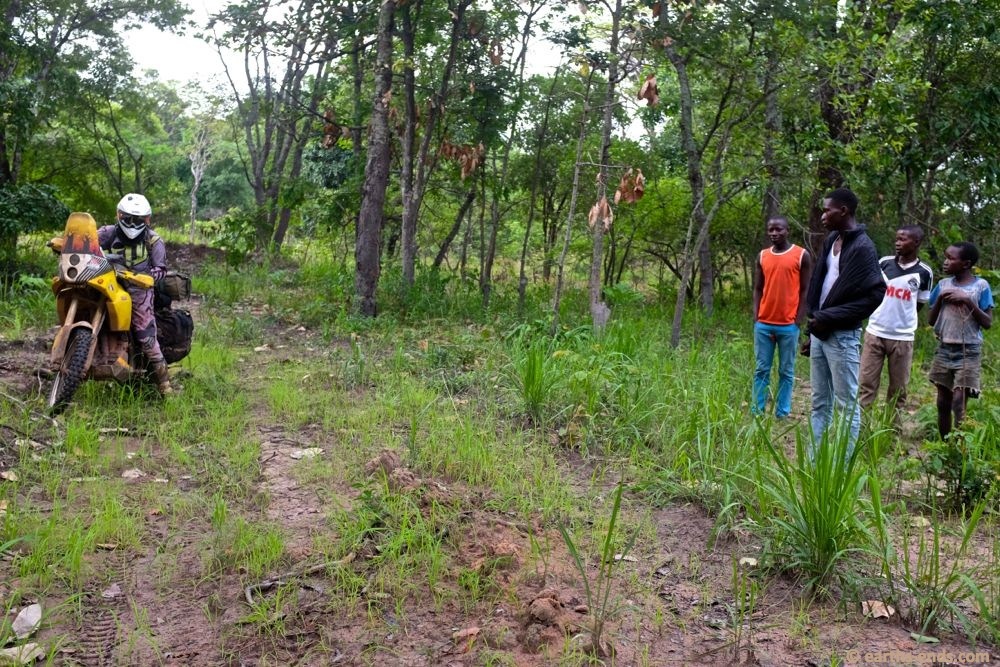
Leaving camp the next day.

A gorgeous start to the day 2. And not a rain cloud in sight.
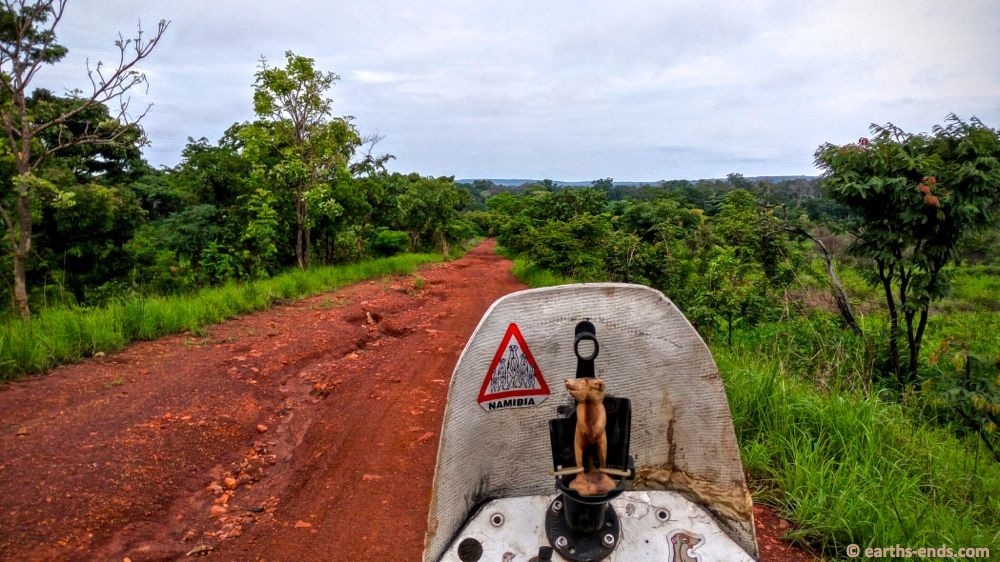
Views of the bush and Arthur, my meerkat totem.

Breakfast was a 5 minute break and a muesli bar.
The morning’s ride took us further north towards the crossing’s rough half way point of Kananga. The trail narrowed and became rougher and wetter than what we’d seen the day before. It varied from some fast gravel, deep eroded track, narrow sandy trail to a fair bit of mud. Nothing too demanding but it was a lot slower going on the muddy sections that had us dodging mud holes and puddles and taking porters lines around the worst of the track’s obstacles. The vegetation was still savannah and woodland but on the whole more dense than the previous day. The weather was stunning and Congo was putting on a show for us. Wet season? What wet season?

More wetlands.

A nice old bridge…and clouds gathering.
While we still came across Congolese going about their daily business this section was considerable more remote with smaller and less frequent settlements seen. It is hard to describe the abruptness of the change in scene and feel from the tar to the dirt sections we had been riding. It was like falling through the rabbit hole. It really was a unique phenomena I felt at this juncture, where the change in mood and feel of the place completely belied the short distance we had ventured from the tar road and very minor passage of time.
Usually for us travelling overland; the sights, sounds and feel of the place more often than not tend to gradually bleed into one another. We very rarely notice stark changes inside a country’s borders. Not so for this section of DRC. It was like falling off a cliff. All of a sudden it felt we were somewhere completely different from everywhere we had been until this point. As we ventured further from the mining centres and into the guts of the country the feeling of isolation and uniqueness of experience only became more pronounced.
Apart from us, there was generally little sign of the modern world. No vehicle wheel tracks, no power lines, not a single bit of rubbish for kilometre after kilometre. We had found what had for the most part eluded us in Africa; somewhere that felt remote and untouched. As we rode along the more narrow and unkempt sections of track it became easier than ever to imagine what the DRC would have been like hundreds of years ago.

47 These guys were fixing a puncture when we came along.
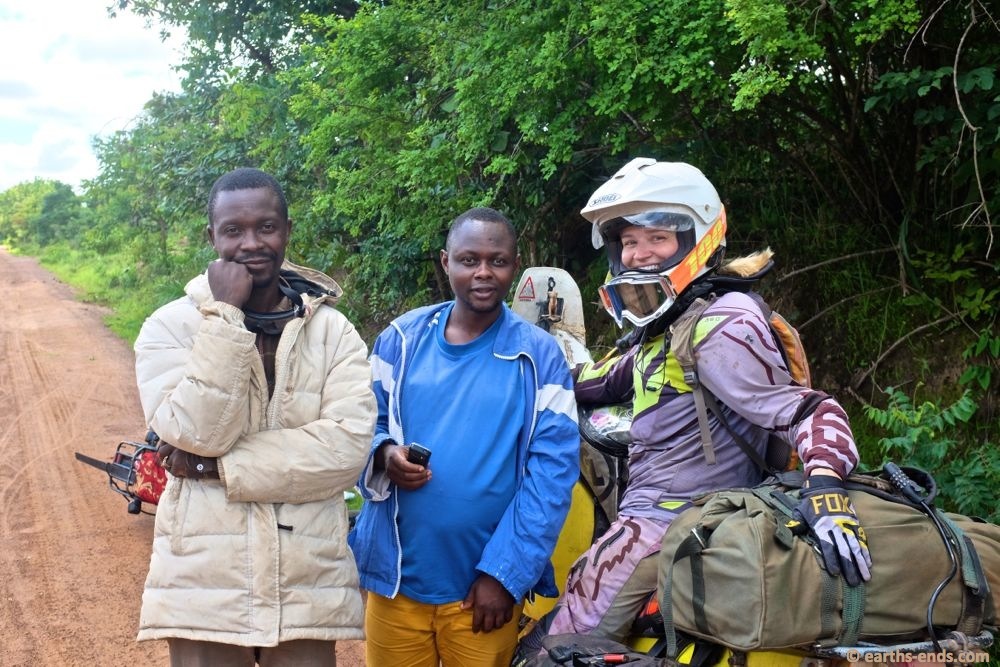
They were stoked when we gave them a bunch of patches.
For all my reading about the DRC it is hard to find much discussion as to what Congo was like before the famous explorer Henry Morton Stanley arrived on the scene. Now I am quite a fan of Stanley but the fact of the matter is there was a heck of a lot going on in the Congo before Stanley came along and followed the Congo River from start to finish.
In the centuries prior, the Kingdom of Kongo, as it was known then, along with the rest of the territory of modern day DRC, was surprisingly well connected with the global economy of the time. And we have the Atlantic slave trade to thank for that. Prior to this time, slavery within Africa (ie African slaves owned by other Africans) was just as common here as many other parts of the world. Within Kongo, slaves were generally the spoils of war or criminals were made slaves as a form of judicial punishment.

On some nice sand track.

Socialising

and giving another motorbiker some spare patches.
But slavery in the Kingdom of Kongo got seriously commercial thanks to the Portuguese. If you are one who thinks globalisation is bad now, it was a genuine bitch in the 14th century. The Portuguese rocked up on the scene and then got friendly with the King of the Kongo. A bit of cultural exchange went on with missionaries being accepted into Kongo first (that ol’trick) and some locals went to Portugal. One such local included the eleven year old son of the King Afonso I of Kongo who went on to learn Portuguese and Latin who then moved to Rome where he became history’s first black Catholic bishop.

It was a stunning day to be out riding.

From sandy trails, to red dirt,

Back to sand again.
From the beginning the Portuguese were pretty keen to get their hands on Kongo’s human merchandise. King Afonso helped them out by conducting slave raids for them in neighbouring regions. But the Portuguese desires for slaves increased to the point the Kingdom was becoming destabilised and depopulated. King Alfonso wrote the following letter to the Portuguese King João III:
“Each day the traders are kidnapping our people – children of this country, sons of our nobles and vassals, even people of our own family. This corruption and depravity are so widespread that our land is entirely depopulated. We need in this kingdom only priests and schoolteachers, and no merchandise, unless it is wine and flour for Mass. It is our wish that this Kingdom not be a place for the trade or transport of slaves.”
He threated to end the slave trade unless the Portuguese submitted to Kongo law regarding slaves. The Portuguese King however talked him around and he instead set up and committee to examine the legality of all slaves presented for purchase. History suggests that didn’t work as intended.
With the arrival of the Portuguese, trade was initiated and the face of Kongo’s society changed forever. Portuguese goods meant trade took off and a merchant class emerged to rival the power of chiefs. Merchants acquired wealth… that could then be traded for weapons and gunpowder. At this time gunpowder became the difference between survival and decimation for tribes. It would take on average 5 years for a keg of it to make it from the coast to the interior but when it did it wasn’t put to waste… or good use for that matter. So gunpowder begat more slaves and more slaves beget more gunpowder and so the cycle continued until before you know it; 350 years have passed, 4 million slaves had been sold and transported and millions more left dead in the process.

Taking a break where I stacked the bike after a hitting a big tree stump with my pannier that was hidden in the tall grass.

Mick having a rest and seeing how we were tracking for the day.

Pulling up for a bit of lunch of something like tuna and crackers, nuts and biltong.

Passing a guy on his way to sell a goat.

Dodging pigs was the mornings challenge. Loved riding past mud holes with lounging pigs that would calmly look us as to say “Sup?”
I have heard people wanting to deflect criticism for nations that took part in the slave trade by mentioning how African chiefs sold their own people into slavery. This is true. But a more nuanced look at the slaving economy that arose would reveal an ‘enslave or be enslaved’ situation. While there were African slave traders in it for money and power, there were more chiefs faced with having to sell their own people in order to buy gunpowder and weapons to protect the remaining members of the tribe from being enslaved by neighbouring tribes, who were themselves looking to ensure their own survival. Enslave, or be enslaved.
It went for centuries like this. Communities fought each other while retreating from ever expanding slaving territories and adopted new rigid hierarchical social structures in order to be better protected. What advances the Kongo might have experienced had centuries of energy not been expended hiding in the jungle and defending themselves? The situation the inhabitants of Central Africa found themselves in was not exactly conducive to the rise of great constructions, written language, economic, agricultural, technological advancement and all the other things that serve as proof to some of an inherent lack of capacity as a people.
So in a nutshell, in addition to serving as an indelible stain on humanity the slave trade did an absolute number on the Congo. The Congo was left devastated, centuries behind the eight ball, divided, disorganised and vulnerable. And then King Leopold II of Belgium came along. And there Congo went, from the fire of the Atlantic slave trade to the frying pan of colonialism.
…
But back to the ride, which incidentally had us travelling west toward the Angola border very closely mirroring one of the main slave caravan routes through Congo.
After some time on the trail we arrive in the small town of Tshimbalanga on the crossroads of the N39 running north to south, and an east-west route connecting central Congo with Angola. We were not far from Sandoa, the largest town in the area by looking at a map, but one we had specifically been warned not to travel to by Pat, the solo Aussie fella on a KTM690 who had been through about 3 weeks before.
Pat was in need of fuel, and decided to head west on the road towards Angola for the 6 or so kilometres needed to reach Sandoa where he was hoping to get reliable fuel. Black market fuel is everywhere but a bit of a risk in terms of quality and cleanliness, plus it is more expensive, so if it is avoidable with a 6km detour… why not? The problem though with bigger towns is the amount of people and the increased likelihood of running into police/immigration types. Thankfully he had is gopro on and managed to capture some of the carnage which was about to play out.

Getting fuel.

They were happy to sell 40l in one go and the kids were happy to have something interesting to stare at.
He did indeed find a proper service station but was soon overrun with locals gawking at him and his bike. It was impossible to move, so the service station attendant grabbed a big piece of hose and started swinging it wildly at the crowd, which backed off enough after a few indiscriminate blows that the attendant was able to put up a security chain around the fueling area to keep the crowd at bay. This action however created a bigger scene, attracting more people to fuel station mosh pit, one of which was a very drunk cop/DGM official who started to yell at Pat, tried to grab him, and when unsuccessful, tried to take some of his stuff. Pat managed to shout enough and make a big enough scene to get him to back off, managed to pay the bill, get on his bike, push off the drunk cop who lunged one more time at him and then accelerated off straight through the jeering crowd.
Did we mention that Congo can be a pretty wild and crazy place? Well, just in case we didn’t, Congo can be a really wild and crazy place. Based on that story we were not going to Sandoa for fuel lest there still be some bad blood around foreign biker types.

A nice little road side café.

Tea break. Best part of my day.

Friendly kiddies

They were a bit spun out by our presence.

We only saw a couple of these trucks in our travels.
Thankfully the town of Tshimbalanga was very small, but it did have a few shops and few guys selling black market fuel. Even though we were now quite isolated, the fuel here was nearly as cheap as in the last main town of Kolwezi, 1450 francs per litre vs about 1400 (about US1.50). This is because the fuel is smuggled over the border from nearby Angola (a significant oil producer) where it is purchased at low cost. We purchased 20l each, filtered through our in tank filters that we use in such situations and were happy to see the fuel was really quite clean. To my great pleasure the town even boasted a small tea stall where we were able to buy a baguette and down some sweet milky tea. Everything was friendly and chilled and we were soon on our way again.

You can see here that I missed the porters track while Mick didn’t. It was a mistake we would both make from time to time. On the worst part of the route (that were to come in a few more days riding) you really paid the price for inattention and if you missed the cheat line you could be stuck for a kilometer in the worst sand before the next opportunity came to escape it.

It was during this section where the trail got quite tricky for the first time.

We encountered some thick and slippery mud.

The tyres were awesome…
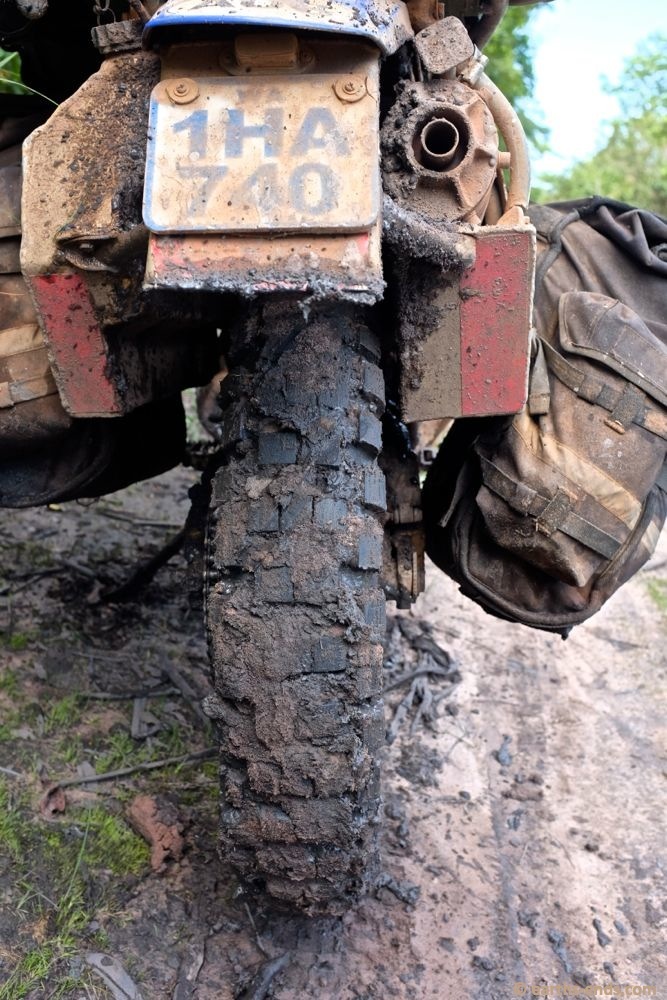
but even they struggle with Congo mud.
We hit the trail once more and had a good afternoon’s ride and saw scarcely a soul. The trail served up the first challenging off-road section but nothing too difficult; just utterly constant technical riding and maneuvering through deep watery muddy trail. Taking the porter lines was really challenging at times where the mud and flooded track was so deep it required a very abrupt climb on the bike on slippery steep embankments. If you didn’t make it you faced a big drop into some deep mud ultimately putting yourself in a shitty position for then having to ride through the worst of the main trail or worse a muddy near drowning experience if you stack it on the way down.

Here we are pulled up at one of the infrequent flat easy parts of the section of the route I referred to as the Great Puddle Gauntlet. Obviously if there was no time to drink there was no time for photos so you’ll just have to imagine the hard stuff.

We are pretty bike fit so it takes a lot to get us this hot and red faced.

It was really humid in the dense forest and mud sections.
Fortunately that didn’t happen to either of us but the fear of it did run through my head on the occasions I found myself maneuvering my overloaded piggy up a steep greasy mud embankments that would be sufficiently challenging on a mountain bike let alone a 200kg fully loaded, fully fueled bike. The cheat line were also extremely narrow in this section and basically just front tyre width so difficult to see with enough time to take advantage of them let alone assess if they were a better option the obstacle in front. Because sometime they proved more perilous as they were very tight and windy through dense forest full of tall thin trees and nasty pannier height stumps. And then at the end of them you might face a sudden large drop back down to the track. It made for really exciting almost sensory overload inducing riding where you simply couldn’t stop and interrupt the flow. It was the type of riding that didn’t even allow sufficient time to take a hand of the bars to place the camelbak tube in your mouth. Great, great riding. I don’t know how long it was like that for but it felt like several hours and was long enough to get a good ache on in the abs and muscles all down the back.

Then we dealt with some rutted deep sand sections. Once again we were concentrating on riding so we didn’t get pictures of the worst of it. To be honest we hate interrupting the ride to take photos.

In places where the ruts are high enough to hit the panniers you tend to get knocked around like a pinball. From left to right in the same wheel track, then bumped over the middle mound then into the right wheel track and back again. Made for some interesting riding.

It was pretty exciting to see the first sign in a long time. But we wouldn’t make it to Kapanga until the following day.

There were some cheat lines out of the worst of the deep sand but you have to be really careful with these as the tended to be high up from the track and had you riding on a camber then huge deep erosion holes could gobble up a motorbike and rider or leave you stranded with no way to turn around accept for trying turn around in thick grass and vegetation off the trail….or having to drop a meter or more down into the sandy wheel tracks.

Luck for us the previous nights rain put enough moisture in the sand to make it a little easier to ride, but not so much as to waterlog it into a harder challenge. As it was this sand wasn’t much of a hassle.
After a long, tiring and pleasant day in the saddle we started scouting for a nice place to bush camp. Where we found ourselves in the late afternoon was ideal in terms of privacy as there we so few people around. However we struggled to find a practical place to park up due to heavy erosion off the trail. Back and forth along a section of trail we went trying to find a place to get the bikes through. Knowing the comfort of the camp chairs, removal of boots and eating of food was not far off made the 20 minutes of searching for a place seem like hours. Eventually Mick came up with the goods and this time checked to make sure there weren’t obvious tyre tracks leading to our camp for the night.

Taking a breather once we hit some nice hard pack.
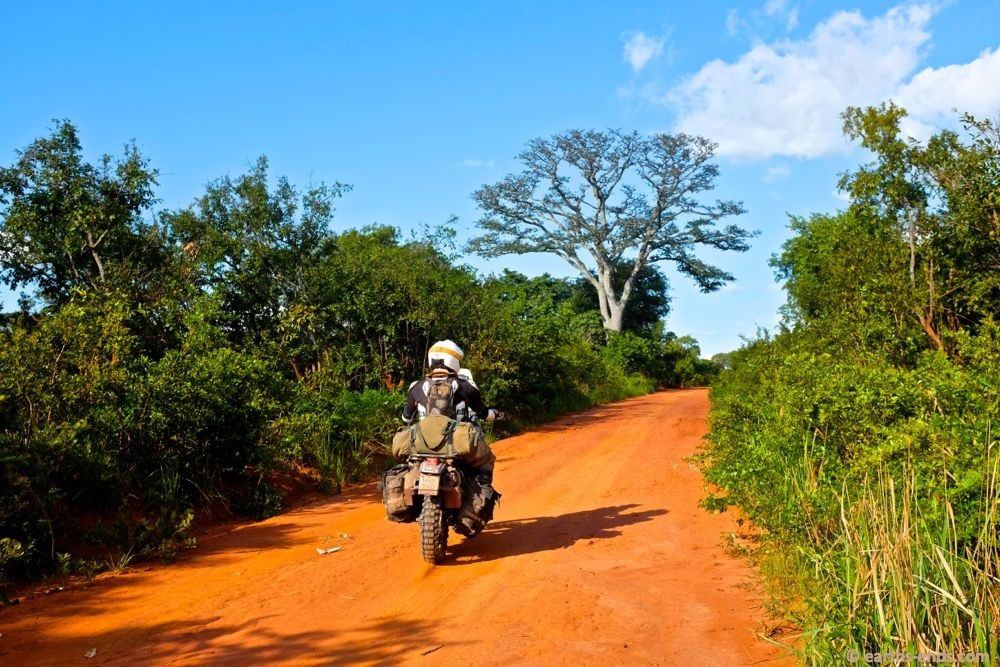
Beautiful Congo.
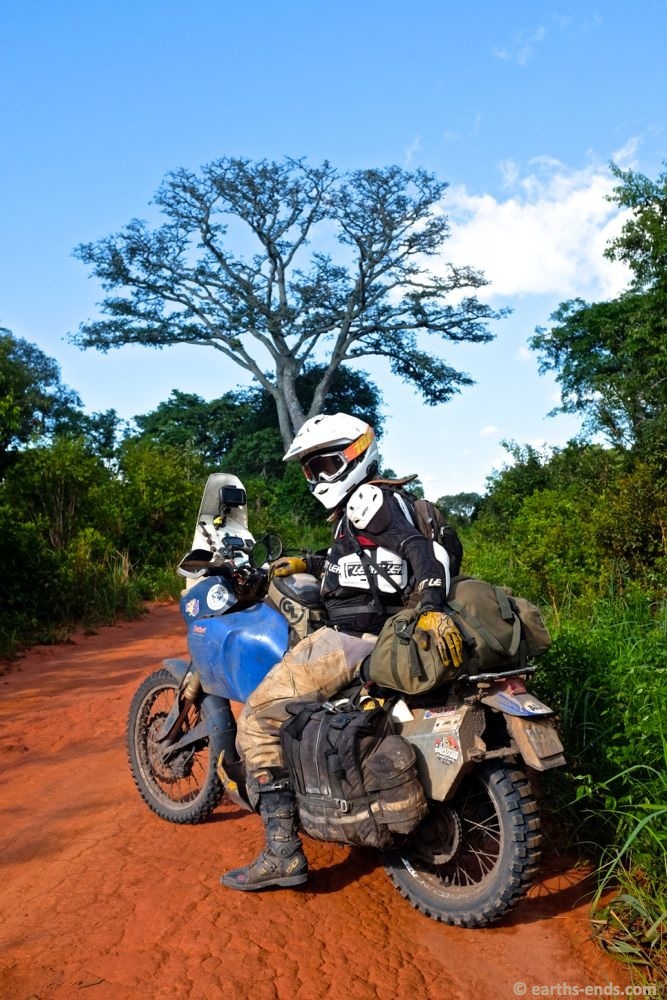
That awesome feeling where you find yourself on terrain so easy you have time to play back all the tough stuff you just rode. This is when its nice having the intercom “hey, how about that gnarly bit where…..” “But then there was that insane bit where….”

Then we hit a eroded gravel section (not eroded here) in lovely savannah territory.

There was even a bridge.
We were exhausted but content after a physically demanding though not too challenging ride. We had knocked off another 220kms in 10 hours, a good effort we thought. We pitched the tent and boiled water for tea and to make one of our dehydrated hikers meals for two. I can’t recall what we ate but it was divine. And we were grateful once more to Richard the Congo aficionado who gave us his left over packets. A great day was finished off in style with a mouthful of sweetened condensed milk and reading a brilliant Stanley biography to the sound of the Congo bush, and later in the evening, another Congo storm. While we were close enough for the sheet lightning to light up the night sky, luck was with us yet again as the thunderstorm rolled over to the south of us, while our route beckoned to the north. We had travelled a good distance in 2 days and had no troubles. I was feeling confident now. And was eager to see how the trail would treat us tomorrow.

The scenery.
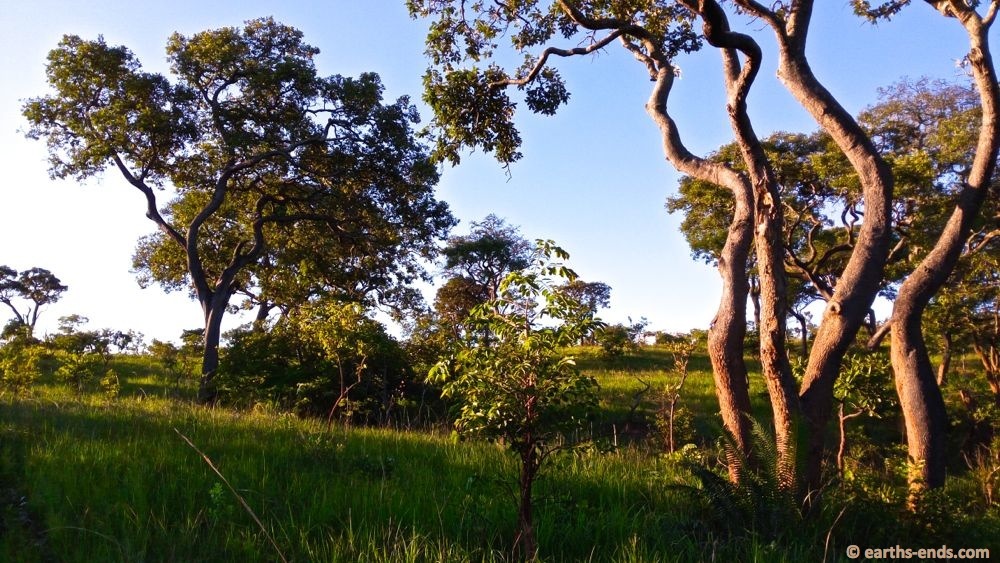
The view from our campsite.

Parked up for the night.
 Earths-Ends
Earths-Ends
Man,I was sweating just reading about that ride,thanks again for sharing this adventure with us..
Great Stuff,Ive beat my DR but nothing like yours get beat! Thanks so much for all the work on the Blog!
Your reports are always smashing – a great read! I’m so glad that you show your campsites at the end of the day – I love camping as much as riding, and so when you’re in the bush I always wonder where you’ll end up for the night!
I’m very glad to have found your blog; it’s so rare to find an account of an adventurous journey which is well written with asides into history deftly woven in.
I’m in the dreaming stage of putting together a long trip through Africa and am looking forward to making my way through your posts. Thank you for publishing this.